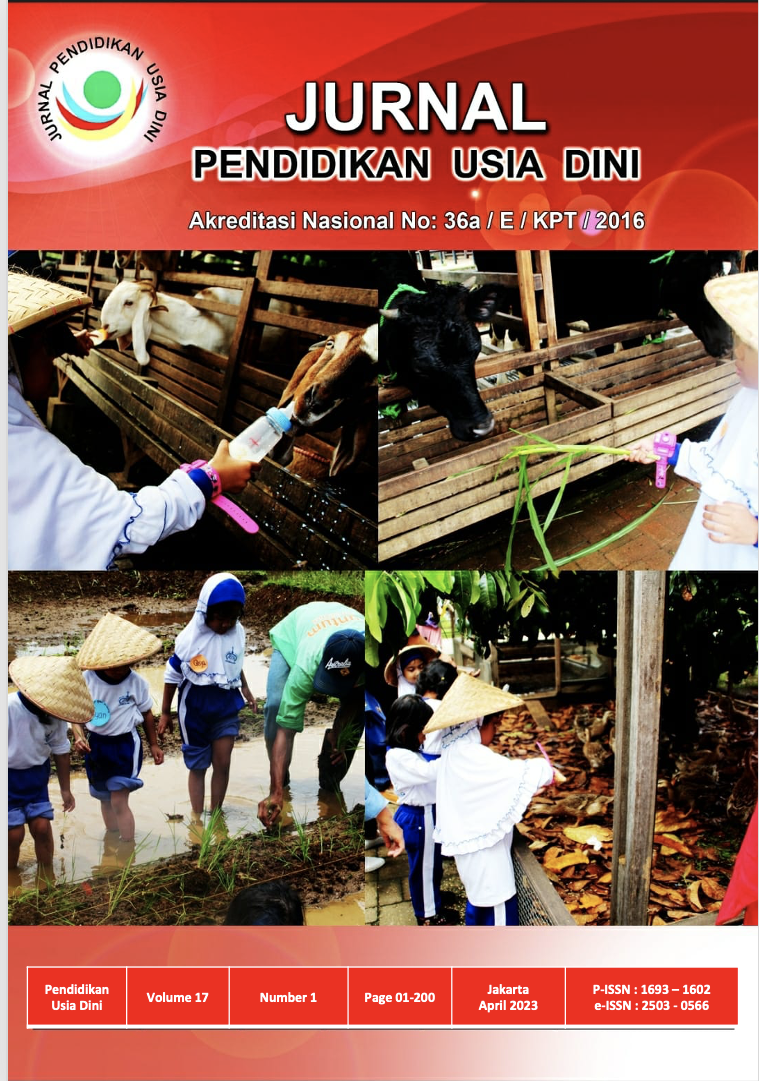Using Smart Apron Learning Media in Teaching Early Literacy Skills
DOI:
https://doi.org/10.21009/JPUD.171.07Abstract
Literacy is one area of academic skills that can help children learn to read more easily and can influence skills in other academic areas. This study aims to describe the use of smart aprons learning media in teaching early literacy skills in schools that already use it in the Greater Jakarta area. This qualitative descriptive research was carried out in August 2022 with 11 teachers as respondents. Collecting data using observation techniques, interviews, and documentation. The validity of the data is obtained through data triangulation. The results of the study show that the use of smart aprons in literacy teaching is implemented in planning, opening learning activities, explaining activities, and closing learning activities, and is used in reflecting on learning about literacy. Besides being used for teaching literacy, smart aprons are also used to stimulate other aspects of development, such as children's cognitive and gross motor skills. Smart aprons are easy to use, time efficient, and flexible and make children enthusiastic about learning, encourage children's motivation, encourage teacher creativity, and children know something that was not previously known and encourage teacher creativity.
Keywords: smart apron media, literacy skills, early childhood
References:
Banerjee, R., Alsalman, A., & Alqafari, S. (2016). Supporting Sociodramatic Play in Preschools to Promote Language and Literacy Skills of English Language Learners. Early Childhood Education Journal, 44(4), 299–305. https://doi.org/10.1007/s10643-015-0715-4
Baroody, A. E., & Diamond, K. E. (2016). Associations among preschool children’s classroom literacy environment, interest and engagement in literacy activities, and early reading skills. Journal of Early Childhood Research, 14(2), 146–162. https://doi.org/10.1177/1476718X14529280
Bodrova, E. (2008). Make‐believe play versus academic skills: A Vygotskian approach to today’s dilemma of early childhood education. European Early Childhood Education Research Journal, 16(3), 357–369. https://doi.org/10.1080/13502930802291777
Buckingham, D. (2019). The Media Education Manifesto. Wiley. https://books.google.co.id/books?id=3m0fvgEACAAJ
Fricke, S., Szczerbinski, M., Fox-Boyer, A., & Stackhouse, J. (2016). Preschool Predictors of Early Literacy Acquisition in German-Speaking Children. Reading Research Quarterly, 51(1), 29–53. https://doi.org/10.1002/rrq.116
Inoue, T., Georgiou, G. K., Parrila, R., & Kirby, J. R. (2018). Examining an Extended Home Literacy Model: The Mediating Roles of Emergent Literacy Skills and Reading Fluency. Scientific Studies of Reading, 22(4), 273–288. https://doi.org/10.1080/10888438.2018.1435663
Landerl, K., Freudenthaler, H. H., Heene, M., De Jong, P. F., Desrochers, A., Manolitsis, G., Parrila, R., & Georgiou, G. K. (2019). Phonological Awareness and Rapid Automatized Naming as Longitudinal Predictors of Reading in Five Alphabetic Orthographies with Varying Degrees of Consistency. Scientific Studies of Reading, 23(3), 220–234. https://doi.org/10.1080/10888438.2018.1510936
Lonigan, C. J., & Shanahan, T. (2010). Developing Early Literacy Skills: Things We Know We Know and Things We Know We Don’t Know. Educational Researcher, 39(4), 340–346. https://doi.org/10.3102/0013189X10369832
Missall, K. N., Carta, J. J., McConnell, S. R., Walker, D., & Greenwood, C. R. (2008). Using Individual Growth and Development Indicators to Measure Early Language and Literacy. Infants & Young Children, 21(3). https://journals.lww.com/iycjournal/Fulltext/2008/07000/Using_Individual_Growth_and_Development_Indicators.8.aspx
Pears, K. C., Kim, H. K., Fisher, P. A., & Yoerger, K. (2016). Increasing pre-kindergarten early literacy skills in children with developmental disabilities and delays. Journal of School Psychology, 57, 15–27. https://doi.org/10.1016/j.jsp.2016.05.004
Pfost, M. (2015). Children’s Phonological Awareness as a Predictor of Reading and Spelling. Zeitschrift Für Entwicklungspsychologie Und Pädagogische Psychologie, 47(3), 123–138. https://doi.org/10.1026/0049-8637/a000141
Piasta, S. B., Purpura, D. J., & Wagner, R. K. (2010). Fostering alphabet knowledge development: A comparison of two instructional approaches. Reading and Writing, 23(6), 607–626. https://doi.org/10.1007/s11145-009-9174-x
Quinn, J. M., Wagner, R. K., Petscher, Y., & Lopez, D. (2015). Developmental Relations Between Vocabulary Knowledge and Reading Comprehension: A Latent Change Score Modeling Study. Child Development, 86(1), 159–175. https://doi.org/10.1111/cdev.12292
Rohde, L. (2015). The Comprehensive Emergent Literacy Model: Early Literacy in Context. SAGE Open, 5(1), 2158244015577664. https://doi.org/10.1177/2158244015577664
Suggate, S., Schaughency, E., McAnally, H., & Reese, E. (2018). From infancy to adolescence: The longitudinal links between vocabulary, early literacy skills, oral narrative, and reading comprehension. Cognitive Development, 47, 82–95. https://doi.org/10.1016/j.cogdev.2018.04.005
Sugiyono. (2008). Metode penelitian pendidikan: (Pendekatan kuantitatif, kualitatif dan R & D). Alfabeta. https://books.google.co.id/books?id=0xmCnQAACAAJ
Wilcox, M. J., Gray, S., & Reiser, M. (2020). Preschoolers with developmental speech and/or language impairment: Efficacy of the Teaching Early Literacy and Language (TELL) curriculum. Early Childhood Research Quarterly, 51, 124–143. https://doi.org/10.1016/j.ecresq.2019.10.005
Zettler-Greeley, C. M., Bailet, L. L., Murphy, S., DeLucca, T., & Branum-Martin, L. (2018). Efficacy of the Nemours BrightStart! Early Literacy Program: Treatment Outcomes from a Randomized Trial With At-Risk Prekindergartners. Early Education and Development, 29(6), 873–892. https://doi.org/10.1080/10409289.2018.1475202
Downloads
Published
How to Cite
Issue
Section
License
JURNAL PENDIDIKAN USIA DINI work is licensed under a Creative Commons Attribution 4.0 International License. (http://creativecommons.org/licenses/by/4.0/)





